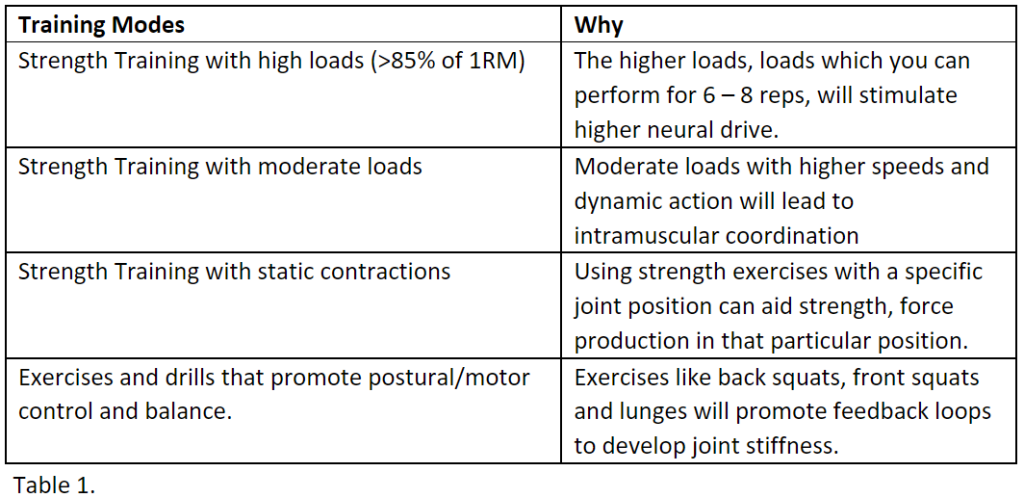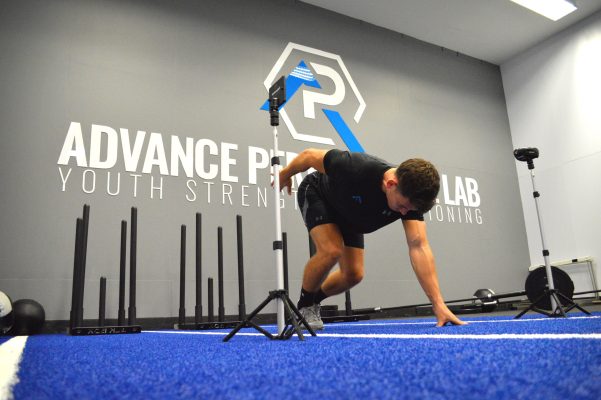Sports like netball, hockey, lacrosse, football, and rugby, to name a few, have very specific technical sport skills, and with the aid of the sports coach, can be practiced, trained, and developed. From a fundamental point of view these specific technical sport skills require a range of physical capacities and skills. For example, throwing a ball requires the ability to generate force (capacity), and the skill(s), aim, and accuracy, along being all tied up in the type of throw.
We can use this capacity and skill concept within essential movements, which and generally used in most sports – sprinting and jumping (this would also apply to change of direction too!).
Both movements require the ability to generate force, again physical capacity, with the technical skill of what we call sprinting and jumping. Obviously, this is a simplistic approach to a complex problem, however, simple ideas and concepts helps to plan and deliver effective training drills and sessions.
The reason I’m bringing this to physical capacity and skill concept to coach’s attention, is that we often see, what I call ‘over-specificity’ within exercises and drills. What do I mean by Over-specificity? This is when a technical sport skill is often loaded to form some sort of overload and then trained. This rarely works, as loading the sport skill changes the mechanics and skill leading to negative transfer and reduced performance.
Therefore, rather than trying to load or overload a technical sport skill, we can take a physical capacity and try to train this specific quality. After which, we can then re-introduce and practice the sport skill or essential skills (sprinting and jumping), with the goal that the new physical capacity will transfer across and improve performance (performance may be an increase in peak force or improvement in economy – I will be writing a blog in economy in the new few weeks).
This is where rate of force development (RFD) steps up! RFD is the ability to generate force relative to a timeframe (this is a very short timeframe, normally expressed in milliseconds (ms). So, RFD is the ability to generate force in approximately the first 100ms. This may sound like overkill or overanalysing, and just getting stronger or more powerful is the same thing, but remember that most sporting movements like sprinting and jumping are performed within narrow timeframes, and therefore, the athlete who can generate force quickly (express their RFD), could be the difference between sprinting to make that tackle or jumping for a high ball!
Now we know what RFD is, how can we train this physical capacity? Studies have reported improvements in RFD using various training modes; let’s see what they say.
Strength Training – Dynamic Training
We know that regular strength training is beneficial due to the neuromuscular adaptations (Haff & Whitley, 2001). For example, recruitment of higher threshold motor units, alterations in rate coding or the frequency of the impulses sent to the higher threshold motor units, and intramuscular coordination (Behm, 1995). These neural adaptations also seem to help in developing RFD.
Studies have used different strength training protocols to compare improvements in RFD. A study by Heggelund et al. (2013) reviewed maximal strength training (heavy loads above 85% 1RM) and regular strength training (loads between 60-70% 1RM). The results of the study reported greater RFD improvements in the heavy loads than the loads of 60-70%. The RFD improvements when using heavy loads is probably due to the recruitment of motor units and intramuscular coordination.
However, study by Guglielmo et al (2009) reported improvements in RFD when using loads of 70% 1RM, but these athletes were asked to explosively move the loads.
So, what does this mean? this means that we can increase RFD using both heavy loads and moderate loads. The heavy loads seem to recruitment higher motor units to improve RFD, where the moderate loads performed at faster velocities seem to develop intramuscular coordination, especially in the concentric action.
Another interesting study was completed by Muehlbauer and Gollhofer (2012), where the researchers wanted to investigate jump height via strength training both in male and female participants (ages 16 – 17 years old). The strength training was prescribed twice a week for eight weeks. The participants performed exercises with loads between 20 – 80% 1RM, with explosive actions. After the eight weeks, the participated were tested in their strength levels and jump height. Both males and females improved their strength and jump height, but what was surprising, is that the female participants significantly increased their jump height, and their RFD (effect size 1.37).

Isometric training – Static Strength Training
Static strength training or isometric training is regularly used in developing athletes, as the exercises rea easier to learn, and the strength adaptations are joint angle specific (Bogdanis et al. 2019). A common type of exercise which is prescribed to athletes is the isometric-mid thigh pull, where the athlete pulls on a static bar (deadlift type position), for a maximal effort for a given amount of time. As this type of exercise requires neural drive to activate as many motor units as possible, alterations and changes in neuromuscular will lead to strength development and RFD. however, as the exercise is in a static position the strength adaptation will occur at that joint angle and doesn’t seem to transfer to dynamic movements (concentric action).
Sensorimotor training – Balance Type Training
Sensorimotor or balance type training is frequently prescribed to athletes who are in rehabilitation and/or returning back to sport (Hale et al. 2007, Holme et al. 1999), however, there is some evidence that balance training may help in RFD (as a foundation to RFD). Performing exercises, which promote postural changes will again alter neural function, but this time it’s believed that the neurological changes are via a feedback loop, as the sensory function is helping with joint integrity and stiffness (Bruhn et al. 2003). This is different to regular strength training, as strength training stimulates motor unit to generate force, whereas balance training may help to enhance joint stiffness in the imitation of strength/force production (Gruber and Gollhofer, 2004).

Practical Applications
As most sports require the athletes to perform dynamic movements like sprinting and jumping, along with other technical sporting skills, it is essential that we train and develop physical capacities like RFD. By training and developing RFD through various training methods (table 1), this will prepare and aid our athletes when practicing specific skills, with the physical capacities transferring across leading to higher performances.

At the Lab and via our Athlete App, we deliver different training methods, block training, concurrent training, and phase potentiation, as these different types of training will help to develop physical capacities, like RFD.
This is yet another reason for athletes to be exposed to strength training, as most sport coaches want their athletes to sprint faster and jump higher. Yes, sprint drills and jump training (we will look at these in the future), are also important factors, but we need to overload and train the physical capacities, before specialised training.
If you would like more information Get in Touch!
References
Behm, D.G. (1995). Neuromuscular implications and application of resistance training. Journal of Strength and Conditioning, 9(4), 264 – 274.
Bogdanis, G.C., Tsoukos, A., Methenitis, S.K., Selima, E., Veligekas, P., & Terzis, G. (2019). Effects of low volume isometric leg press complex training at two know angles on force-angle relationship and rate of force development. European Journal of Sport Science, 19(3), 345 – 353.
Bruhun et a; (2003). The effects of a sensorimotor training and a strength training on postural stabilisation, maximal isometric contraction and jump performance. Int J Sports Medicine, 25, 56 – 60.
Gruber, M., & Gollhofer, A. (2004). Impact of sensorimotor training on the rate of force development and neural activation. European Journal of Applied Physiology, 92, 98 – 105.
Guglielmo, L., Greco, C., & Denadai, B. (2009). Effects of strength training on running economy. Int J Sports Med, 30(1), 27 – 32.
Haff, G.G., & Whitley, A. (2001). A brief review: explosive exercises and sports performance. National Strength & Conditioning Association, 23(3), 13 – 20.
Hale, S.A., Hertel, J., & Olmsted-Kramer, L.C. (2007). The effect of a 4-week comprehensive rehabilitation program on postural control and lower extremity function in individuals with chronic ankle instability. Journal of Orthopaedic & Sports Physical Therapy, 37(6), 303 – 311.
Heggelund, J., Fimland, M.S., Helgerud, J., & Hoff, J. (2013). Maximal strength training improves work economy, rate of force development and maximal strength more than conventional strength training. Eur J Appl Physiol, 113, 1565 – 1573.
Holme, E., Magnusson, S.P., Becher, K., Bieler, T., Aagaard, P., & Kjaer, M. (1999). The effect of supervised rehabilitation on strength, postural sway, position sense and reinjury risk after acute ankle ligament sprain. Scand J Med Sci Sports, 9, 104 – 109.
Muehlbauer, T., & Gollhofer, A. (2012). Sex-related effects in strength training during adolescence. A pilot study. Perceptual and Motor Skills: Exercise and Sport, 115(3), 953 – 968.



